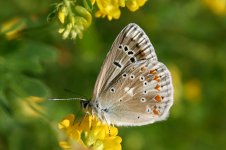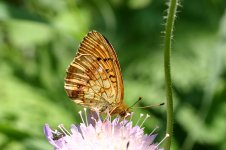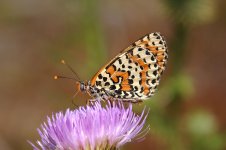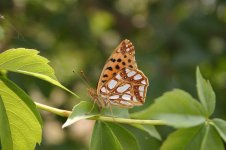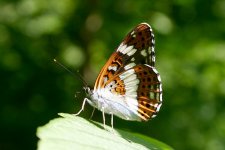
Early July, eastern Lithuania, peak butterfly season ...off for a mega day, an impressive forty-seven species under the belt by day's end.
Kicked off in the Labanoras area, initial mooching around revealing a relatively limited bunch of species such as the standard Heath Fritillaries, Ringlets and Small Heaths typical of the area, but with a move to a flower-rich embankment adjacent to wetlands things took a decided upswing – not only an impressive four species of coppers (Large Copper, Scarce Copper, Purpleshot Copper and Purple-edged Copper), but also both Small Pearl-bordered Fritillary and Lesser Marbled Fritillary, neither particularly abundant butterflies on my day-to-day searches. However, pride of place at this locality, flitting from flower to flower in quite a damp area, a very nice Geranium Argus – a very localised species in Lithuania and the second I have ever seen in the country. In total however, 18 species of butterfly at this locality, not particularly high.
For any hope of a high total, an approximate ad hoc plan evolved for the remainder of the day - shifting 90 km, my next localities were among my favourite butterfly sites in the country: forest rides and meadows to the south of the capital and nearby heaths – in the peak of the season, 30 to 35 species per day are not unusual. With the relatively low numbers this year however, I was far from sure this would be achievable. First up, a long forest ride and flowery margins – Silver-studded Blues and Amanda's Blue, White Admiral, High Brown Fritillary and Silver-washed Fritillary, the tally rose. Numbers not exceptionally high, but the variety was there. One Large Wall Brown, the trio of Pearly, Chestnut and Small Heaths, a grand total of four skipper species, the best being a couple of smart Large Chequered Skippers. At the end of the ride, I broke out into open meadow – Queen of Spain Fritillaries greeted me, one of my favourite of all butterflies. Also Commas, more White Admirals, a very early Pale Clouded Yellow, a couple of Weaver's Fritillaries and both Scarce and Purple-edged Coppers. 28 species recorded in this little segment, 14 new to the day.
A short drive away, an area of heath and adjacent forest land offers opportunity for a few restricted-range species, so an hour or so here also added more – key among these, freshly emerged Spotted Fritillaries, a single Niobe Fritillary, a good number of Moorland Clouded Yellows and, after considerable searching, two or three Graylings (searched high and low on the heaths, then found them settling on my car!). Also added Lesser Purple Emperor here, plus Reverdin's Blue and Small Copper. I failed however to find Rock Grayling, a species usually quite common at this spot. Still, 20 species seen, eight new to the day, the session's tally was now sitting at 40 species!
To add a few more, I need to add kilometres – in late afternoon, I quickly zipped to a road embankment some kilometres west of Vilnius, smoothly adding Turquoise Blue at a regular location for the species (but failing to find either Little or Short-tailed Blues, also sometimes at the same site), then moved a little to the north to end the day in Dukstos Regional Park. Lots of old deciduous forest here, plus flower-rich meadows ...by hook and crook, seeking them out along the edge of woodland and in meadow, a total of 20 species noted in these final hours of the day, six new to the day: Holly Blue, Mazarine Blue, Purple Emperor, Large Tortoiseshell, Painted Lady, Woodland Brown.
So, in a year far from classic, a grand total of 47 species seen. I missed a few common species, such as Red Admiral and Peacock, and failed to find several that I could expect on a dedicated day, including Dingy Skipper, Rock Greyling, Little Blue, Short-tailed Blue. Also no hairstreaks, but these are never easy. So, all in all, not bad – especially given it was still about a week short of the absolute peak of the season. In a previous year, with a little bit of planning, I have managed 53 species in a single day ...a total I think can easily be broken. But with long sunny days remaining elusive, I fear not this year!
Kicked off in the Labanoras area, initial mooching around revealing a relatively limited bunch of species such as the standard Heath Fritillaries, Ringlets and Small Heaths typical of the area, but with a move to a flower-rich embankment adjacent to wetlands things took a decided upswing – not only an impressive four species of coppers (Large Copper, Scarce Copper, Purpleshot Copper and Purple-edged Copper), but also both Small Pearl-bordered Fritillary and Lesser Marbled Fritillary, neither particularly abundant butterflies on my day-to-day searches. However, pride of place at this locality, flitting from flower to flower in quite a damp area, a very nice Geranium Argus – a very localised species in Lithuania and the second I have ever seen in the country. In total however, 18 species of butterfly at this locality, not particularly high.
For any hope of a high total, an approximate ad hoc plan evolved for the remainder of the day - shifting 90 km, my next localities were among my favourite butterfly sites in the country: forest rides and meadows to the south of the capital and nearby heaths – in the peak of the season, 30 to 35 species per day are not unusual. With the relatively low numbers this year however, I was far from sure this would be achievable. First up, a long forest ride and flowery margins – Silver-studded Blues and Amanda's Blue, White Admiral, High Brown Fritillary and Silver-washed Fritillary, the tally rose. Numbers not exceptionally high, but the variety was there. One Large Wall Brown, the trio of Pearly, Chestnut and Small Heaths, a grand total of four skipper species, the best being a couple of smart Large Chequered Skippers. At the end of the ride, I broke out into open meadow – Queen of Spain Fritillaries greeted me, one of my favourite of all butterflies. Also Commas, more White Admirals, a very early Pale Clouded Yellow, a couple of Weaver's Fritillaries and both Scarce and Purple-edged Coppers. 28 species recorded in this little segment, 14 new to the day.
A short drive away, an area of heath and adjacent forest land offers opportunity for a few restricted-range species, so an hour or so here also added more – key among these, freshly emerged Spotted Fritillaries, a single Niobe Fritillary, a good number of Moorland Clouded Yellows and, after considerable searching, two or three Graylings (searched high and low on the heaths, then found them settling on my car!). Also added Lesser Purple Emperor here, plus Reverdin's Blue and Small Copper. I failed however to find Rock Grayling, a species usually quite common at this spot. Still, 20 species seen, eight new to the day, the session's tally was now sitting at 40 species!
To add a few more, I need to add kilometres – in late afternoon, I quickly zipped to a road embankment some kilometres west of Vilnius, smoothly adding Turquoise Blue at a regular location for the species (but failing to find either Little or Short-tailed Blues, also sometimes at the same site), then moved a little to the north to end the day in Dukstos Regional Park. Lots of old deciduous forest here, plus flower-rich meadows ...by hook and crook, seeking them out along the edge of woodland and in meadow, a total of 20 species noted in these final hours of the day, six new to the day: Holly Blue, Mazarine Blue, Purple Emperor, Large Tortoiseshell, Painted Lady, Woodland Brown.
So, in a year far from classic, a grand total of 47 species seen. I missed a few common species, such as Red Admiral and Peacock, and failed to find several that I could expect on a dedicated day, including Dingy Skipper, Rock Greyling, Little Blue, Short-tailed Blue. Also no hairstreaks, but these are never easy. So, all in all, not bad – especially given it was still about a week short of the absolute peak of the season. In a previous year, with a little bit of planning, I have managed 53 species in a single day ...a total I think can easily be broken. But with long sunny days remaining elusive, I fear not this year!
Last edited:




